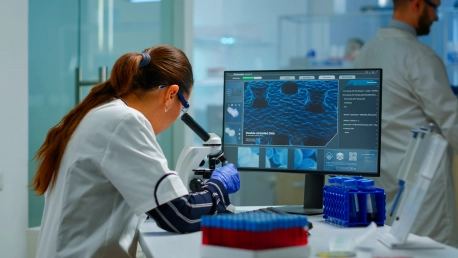Antibiotic resistance represents a growing danger, transforming into a critical global health concern as bacteria evolve to outsmart existing medications, putting countless lives at jeopardy. The situation necessitates the immediate creation of new antibiotics, a task with high stakes and complexities. In response, the scientific community is turning toward the innovative potential of artificial intelligence (AI). This strategic integration of AI into drug discovery marks a pivotal shift, offering hope in the battle against dangerous, resistant pathogens. Utilizing AI’s data-processing and pattern-recognition strengths, researchers are now at the forefront of not only expediting the development of novel antibiotics but also personalizing them to tackle the formidable challenge posed by antibiotic-resistant bacteria. The deployment of AI in this field is not just a stride forward; it could spark a significant breakthrough in preserving global health by equipping humanity with the tools needed to outpace these microbial threats.
The Escalating Crisis of Antibiotic Resistance
Antibiotic resistance stands as a menacing threat to the fabric of global public health. Each year, the number of cases where essential drugs fail against pathogens increases, leading to a surge in fatalities. Traditional drug discovery methods, bound by the confines of existing drug compound libraries, are ill-equipped to adapt to the dynamic and rapid evolution of bacteria. This breach in our medical defenses calls for a radical shift toward more inventive and rapid means of antibiotic development—a challenge AI is uniquely positioned to address. Innovative approaches are critically required, with AI poised as a key to unlocking a new wave of antibiotic treatments.The stakes have never been higher in the battle against antibiotic resistance. The traditional ramparts of drug discovery are proving insufficient in both pace and direction. We are in a race against time, with bacteria outpacing our efforts, demanding a radical overhaul of our approach. Artificial Intelligence (AI) may hold the key — a tool sophisticated enough to outmaneuver the complex adaptability of bacterial pathogens. Modern ingenuity, backed by computational prowess, enters the fray against one of the most pressing medical challenges of our time, ushering in the hope of not just keeping pace but staying a step ahead.
A Revolutionary AI Approach in Antibiotic Discovery
Stanford Medicine and McMaster University researchers have made a significant breakthrough with SyntheMol, a generative AI designed to revolutionize antibiotic development. This cutting-edge model sifts through chemical compounds to craft innovative antibiotic structures, speeding up drug discovery and offering a glimpse into new therapeutic horizons. Unlike traditional methods, SyntheMol expedites the identification of promising molecules, propelling drug development into a new era of efficiency and effectiveness. As SyntheMol navigates complex chemical spaces, it uncovers antibiotics previously inconceivable to human researchers. This leap in technology underscores the emergence of generative AI as a key driver in confronting global health challenges by introducing a wave of potential treatments that could be the answer to the growing issue of antibiotic resistance.
Expanding the Chemical Universe Through AI
Generative AI has transformed the pursuit of new antibiotics by tapping into a chemical space that is vast beyond human comprehension. With SyntheMol’s library of over 130,000 molecular building blocks, the AI model sifts through innumerable combinations to propose drug candidates with unparalleled speed. The exploration of this infinite chemical universe has been dramatically expedited by AI, delivering thousands of potential antibiotics that could have otherwise taken decades to discover through traditional research methods.Such expansion of the chemical universe is a monumental stride in drug discovery. SyntheMol embodies the bridge between the chemical unknown and potential lifesaving antibiotics. It has dissected, recombined, and presented a multitude of candidates in mere hours—candidates that may have remained concealed within the boundless expanse of molecular structures. AI’s ability to propel us deeper into this uncharted territory is a testament to its immense impact on the future of pharmaceutical innovation.
From Computational Designs to Laboratory Validation
AI’s role doesn’t end at the computational conception of potential drugs; SyntheMol’s laboratory validation is critical in cementing the role of these compounds as antibiotics. Among the multitude synthesized, six standout molecules present a beacon of hope, varied in structure and potentially transformative in the fight against bacterial resistance. Yet, their true impact hinges on understanding their molecular mechanisms when combating pathogens—a puzzle that persists beyond their initial discovery.Despite being in its infancy, these AI-generated structures carry the potential to rewrite the narrative of antibiotic resistance. Preliminary tests on select compounds reassure their safety profile in mammals, yet the path to clinical application is complex and nuanced. This symbiotic journey of AI design and empirical testing is fundamental, standing as a pillar for the innovation and realization of new frontline defenders in antibiotic therapy.
Beyond Antibiotics: The Versatility of AI in Pharmaceutical Development
The prowess of SyntheMol and AI extends its reach beyond the creation of antibiotics. The same principles guiding the hunt for antimicrobial drugs are being refashioned to address other medical domains such as cardiovascular diseases and the enhancement of research tools like specialized fluorescent molecules. This versatility heralds a broader impact for AI in pharmaceuticals, potentially revolutionizing how new therapies are created across a spectrum of health conditions.This versatility underscores AI’s profound ability to innovate. By re-tooling SyntheMol’s generative aptitude, researchers can journey through the chemical cosmos not only in search of antibiotics but also for compounds that could revolutionize treatments across a diversification of diseases. AI, with its capacity to imagine and reinvent the molecular, is rapidly becoming an indispensable ally in the quest to deliver new, efficacious drugs to the market.
The Synergy of AI with Advanced Techniques in Drug Development
AI’s confluence with sophisticated techniques in drug development like fragment-based drug design (FBDD) and surface plasmon resonance (SPR) culminates in a synergy that is reshaping the pharmaceutical landscape. This integration promises heightened precision and a hastened pace of development. The role of AI thus becomes a cornerstone in meeting the burgeoning need for high-throughput systems that ensure scalability and maintain data integrity, paving the way for a profound transition in scientific labor toward innovation.These sophisticated methods, once the sole preserve of meticulous human hands, now find efficiency and enhancement through AI. From FBDD’s scrupulous analysis of molecular fragments to the precise detection capabilities of SPR, AI is elevating pharmaceutical research to unprecedented heights, sculpting a future where nimbleness and accuracy define the conduct of medical science.The emergence of AI, exemplified by innovations like SyntheMol in antibiotic creation, is a game-changer. It’s set to slash the timelines for bringing new drugs to market, offering hope in the race against antibiotic resistance. AI empowers researchers to navigate the vast chemical space efficiently, providing a potential solution to this global health challenge. This leap forward is not just about speed; it’s about smarter, more targeted drug development that aligns with the intricate nature of human diseases. The melding of big data, machine learning, and bioscience could lead to medical milestones previously out of reach. As AI hones the pharmaceutical landscape, it paves the way for an era of quicker, more precise treatments, marking a significant stride in safeguarding human health and transforming public health prospects.









